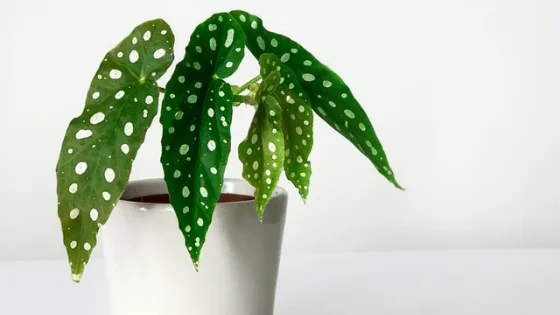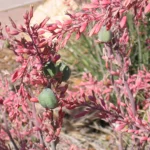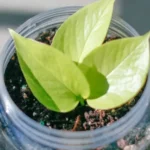Table of Contents
Caring for Begonia Maculata
Begonia Maculata, also known as the Polka Dot Begonia, is a plant that originated in Brazil.
It is a gorgeous, tropical plant, and once you’ve gotten the hang of the moisture balance, it can be a fantastic conversation piece, and the Begonia Maculata has been growing in popularity as a houseplant as a result.
Begonia Maculata is a cane begonia. It has angel wing leaves. The tops of the leaves are olive green with silvery spots that make for a beautiful contrast.
To make the visual even more drastic, the undersides of the leaves are a lovely crimson. This plant also flowers a few times a year, growing clusters of white or pink flowers with yellow centers.
Helping Begonia Maculata Thrive
Like most plants, Begonia Maculata has specific conditions it likes best. It can seem like a lot of work to get things just right, but once you’ve succeeded, it’s relatively easy to keep the plant happy from there.
Begonia Maculata grows fairly quickly. It likes having its roots fairly dense within a pot, and it does best when repotted each spring into a pot no larger than one size up from the last.
Because the roots stay so densely packed, the soil gets quite worn out, and Begonia Maculata benefits from this annual repotting even if you’re not changing the size of the pot.
Yellow or brown leaves indicate that something isn’t quite right in the environment. White or brown spots can indicate fungus or other growths.
Keep an eye out for any of these signs that something needs to be adjusted to keep the Begonia Maculata happy.
Light Requirements
Bright, indirect light is best for Begonia Maculata. Remember, this is a relatively small tropical plant.
It thrives when there is an abundance of sun, but little or none hitting it directly; in the tropics, it would be shielded by larger plants. Too much direct sun will quickly scorch the beautiful plant.
If your options are too much light or too little, Begonia Maculata does a little better in lower light.
It will not grow as quickly and won’t bloom often, if at all, but it won’t be as certain to come to harm as when it’s in the direct sun, especially if you’re in a climate with bright, hot sunlight.
Temperature Requirements
As a tropical plant, Begonia Maculata does best in warm temperatures. It can come to harm pretty quickly below 60 degrees Fahrenheit, but it’s comfortable with day-to-day temperatures of up to 85 degrees.
This temperature range makes it pretty compatible with most people’s indoor living temperatures.
It can withstand temperatures above its comfort range much better than temperatures below 60 degrees.
Soil Requirements
Begonia Maculata is particularly susceptible to root rot, so it’s good to choose a potting mix that is well-aerated.
You might also consider a layer of small rocks at the bottom of the pot, beneath the soil, to help keep wet soil from coming into sustained contact with the roots.
Humidity Requirements
Begonia Maculata appreciates a humid climate. 45% humidity is often recommended as minimum. If you live in a humid area, you may not need to put forth any effort to achieve this.
In a dry climate, consider using a humidifier or keeping the plant in a well-lit bathroom, where the humidity might be higher than other areas of the house.
How to Water Begonia Maculata
How often you water the Begonia Maculata will depend on how quickly it drinks the water. This will be faster in the growing seasons of spring and summer.
If you have a well-aerated soil with a pot that drains well and live in a dry climate, you may need to water as often as every four days.
If you live somewhere damp or don’t have optimal drainage, you might wait a good deal longer before watering.
Begonia Maculata likes moist soil, but it’s very susceptible to root rot and cannot handle the soil staying very wet.
As a general rule, check to make sure the top inch of soil is dry before adding more water.
You can also watch the leaves; if the leaves start turning yellow, it’s probably being over-watered, and if the leaves start falling off or the plant is drooping, it might need more water than it’s getting.
Try not to get the leaves wet when watering. If you’re unable to water it without getting water on the leaves, consider watering it from the bottom. Remember, the goal is moist soil, not a wet plant, which is more likely to develop bacterial leaf spots.
How to Fertilize
Use a balanced fertilizer every 2-4 weeks during spring and summer. For Begonia Maculata, it’s generally a good idea to dilute the fertilizer to around 50% before using.
Pruning
Pruning can help keep the Begonia Maculata from getting too lanky or sparse looking. For a neat, compact aesthetic with even growth, prune twice a year, or more frequently to lesser degrees.
Propagation
Despite the balance required to keep a Begonia Maculata happy, it’s actually fairly easy to propagate this plant. Cuttings of leaves (with at least an inch of stalk or stem) grow well in water before being transferred to a small pot.
They can also be planted directly into a pot with a powdered root hormone. Once it’s growing, you already know how to keep it happy!
Extra tips for Begonia Maculata care
Pests and Diseases
The same humidity that lets Begonia Maculata thrive can also encourage unwanted fungus, bacteria, and pests.
Fungus
If you see white, powdery spots starting to develop on the leaves, remove the affected leaves before this fungus can spread. Fungus can also present as brown growth near the soil.
Bacterial Leaf Spots
Brown growths can be bacteria and are usually caused by water getting on the leaves. Remove the affected leaves.
Rot
If the plant starts turning black or mushy, that means the soil was staying too wet and the plant developed rot. There isn’t really treatment for this, so it’s very important to prevent it with careful watering.
Mealybugs
Begonia Maculata does sometimes attract mealybugs. Remove the infestation and apply a gentle insecticide. Consider including beneficial bugs such as ladybugs to help keep down on unwanted pests.
Toxicity
Begonia Maculata is toxic to pets and can cause irritation in humans if ingested. The roots are more toxic than the leaves.
Quick Reference
- Light: Bright & indirect
- Temperature: 59 to 85 degrees Fahrenheit
- Soil: Moist but not wet. Potting soil needs to drain well
- Humidity: Average to high
- Water: When top inch of soil is dry, generally 4-10 days
- Pruning: Twice a year or as needed to keep the plant compact



